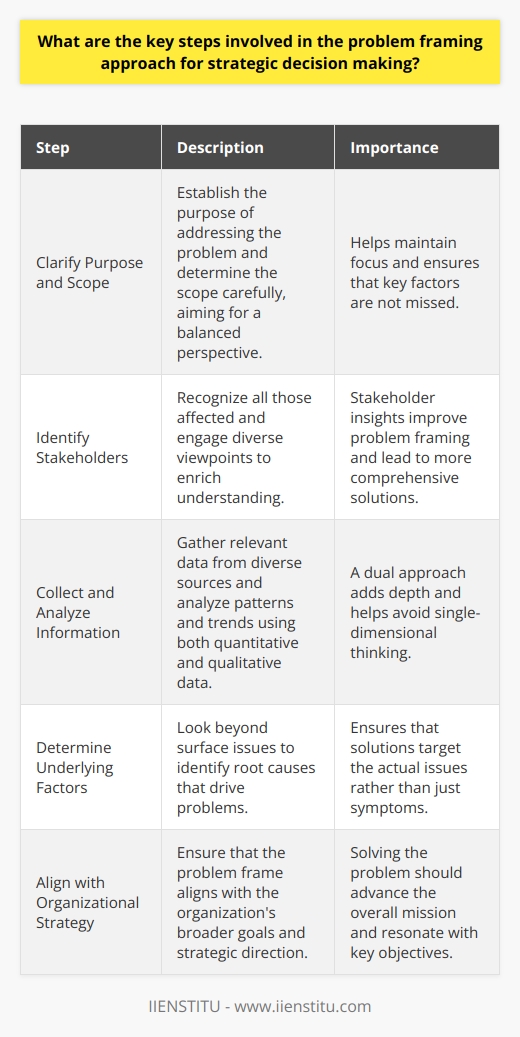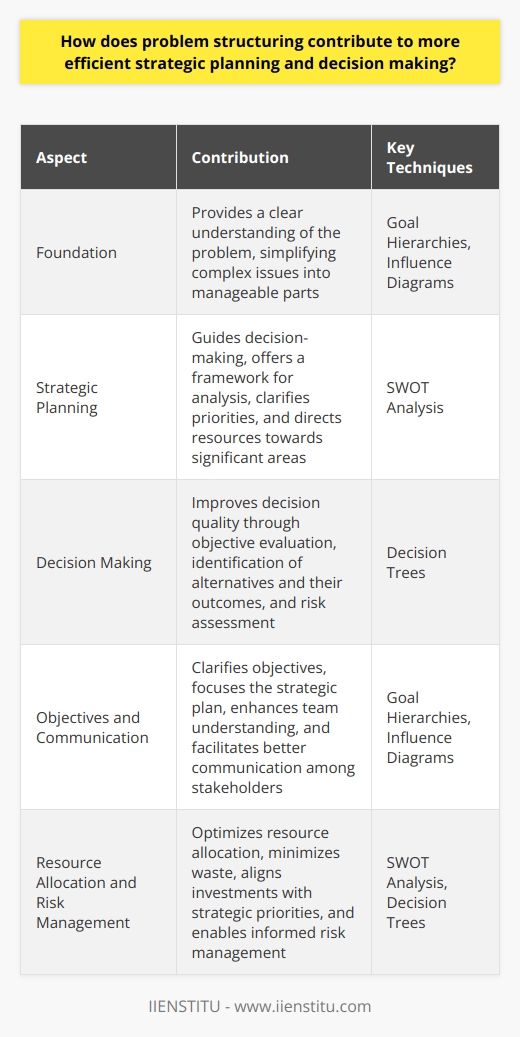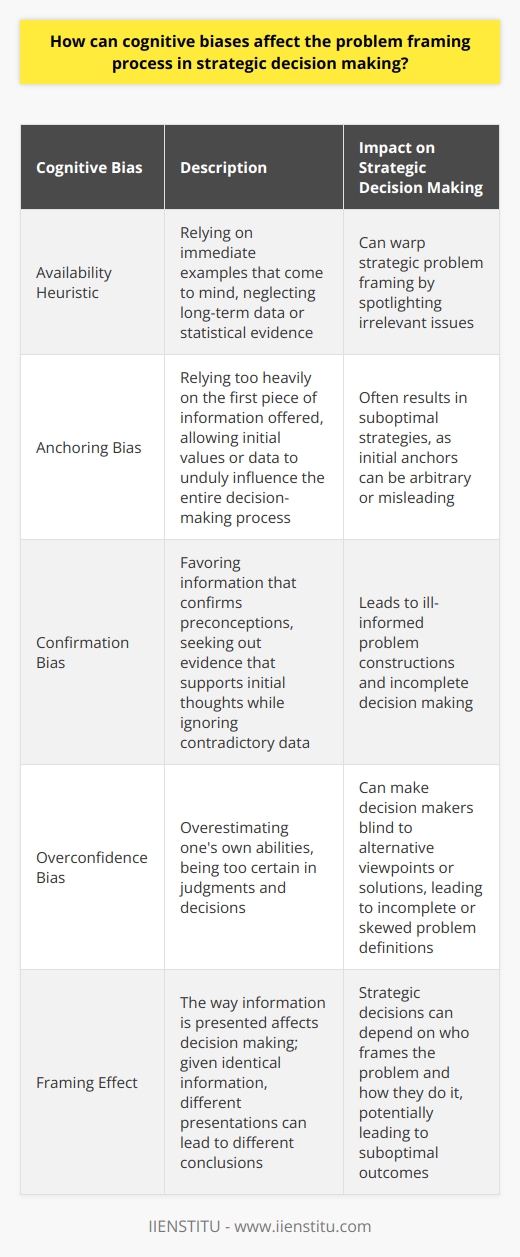
Problem framing stands at the heart of effective decision-making, integrating complex dynamics that range from cognitive psychology to strategic business analysis. This nuanced approach to problem-solving emphasizes the careful definition and understanding of a problem before pursuing a solution. As a methodology, it commands a pivotal role in both individual and organizational contexts. In this article, we will explore the significance of problem framing and delve into its practical applications, providing a scaffolding for those seeking to enhance their decision-making acumen, potentially culminating in the attainment of a problem solving certificate or equivalent recognition through online certificate programs.
Understanding the Concept of Problem Framing
Role of problem framing in problem-solving
The essence of problem framing lies in its ability to transform ambiguous situations into actionable ones. At its core, the process involves delineating the boundaries of a problem, highlighting its context, and clarifying its components. Effective problem framing is akin to setting the stage for a play, where each actor knows their cues, lines, and actions.
For instance, when a healthcare system faces inefficiencies, a well-framed problem might pinpoint the bottleneck in patient flow rather than vaguely addressing 'system issues'. Through such precision, stakeholders are able to align their efforts and resources towards a coherent solution.
Psychological aspects of problem framing
The act of framing a problem is not immune to the inherent biases and perspectives that each individual brings to the table. For instance, a manager might focus on financial inefficiencies when framing a business problem, influenced by their quantitative background, whereas a human resources professional might prioritize workforce morale and engagement.
Acknowledging the different lenses through which a problem can be viewed is essential for a holistic approach. Further, cognitive biases such as confirmation bias or anchoring can inadvertently shape the framing process, thus awareness and mitigation of these tendencies are paramount for objectivity.
Steps in Problem Framing
Identifying the problem
Problem Solving Techniques: A Comprehensive Examination and Analysis
Problem Solving Model: A Comprehensive Analysis of Its Key Components
Fundamental to problem framing is the precision with which a problem is identified. Misidentification can derail the entire problem-solving process, akin to misdiagnosing an ailment. Techniques such as root cause analysis or the "Five Whys" technique can be invaluable in peeling back the layers of an issue to reveal its core. For example, a drop in sales might initially seem like a marketing problem but could ultimately stem from a deeper product design flaw that fails to meet user needs.
Defining goals and objectives
Once a problem is thoroughly identified, the next step involves the articulation of clear, attainable goals and objectives. This is akin to charting a map before embarking on a journey, ensuring that all efforts align with desired outcomes.
Case studies from industries such as technology or manufacturing regularly reveal that a well-considered goal can mean the difference between an effective solution and a misplaced effort.
Formulating the problem statement
Crafting a compelling problem statement is an art that balances specificity with comprehensibility. This statement serves as a guiding star throughout the problem-solving process, keeping the focus squarely on the issue at hand. A powerful problem statement not only clarifies the problem but also implicitly suggests the domains in which solutions may be found, ultimately setting the stage for creative and effective problem-solving.
Strategies for Effective Problem Framing
Considering multiple perspectives
Incorporating a plurality of perspectives is not just beneficial but essential for robust problem framing. By engaging diverse viewpoints, an organization can forestall the tunnel vision that often accompanies homogenous thinking. Methods to cultivate this diversity include cross-functional teams, workshops, and inclusion initiatives that invite a wide array of experiences and expertise to the table.
Encouraging creativity and innovative thinking
Innovation is the lifeblood of effective problem framing. Encouraging team members to think outside the box, to question underlying assumptions, and to dare to envision radically different scenarios can lead to revolutionary, rather than merely incremental, solutions. Strategies such as design thinking workshops or brainstorming sessions can stimulate the divergent thinking necessary to reframe problems in novel ways.
Use of decision-making tools in problem framing
Decision-making tools ranging from SWOT analyses to decision matrices offer structured approaches to dissecting and understanding a problem. These tools help by adding clarity, quantifying intangibles, and facilitating comparison between various components of a problem. Their application can sharply focus the framing process, ensuring that the resulting frame is analytically sound and comprehensive.
Common Mistakes in Problem Framing
Rushing through the framing process
One of the most pervasive mistakes in problem framing is the haste with which it is often approached. The urgency to find solutions can overshadow the need for a well-considered problem frame. Premature framing can lead to misdirected efforts, wasted resources, and ultimately, ineffective solutions. It is, therefore, crucial to dedicate ample time to develop a comprehensive understanding of the problem.
Influence of biases and prejudices
No individual or group is free from biases and prejudices, and their influence on problem framing can be particularly insidious. These subjective leanings can skew problem identification, goal setting, and even the selection of decision-making tools. It is therefore essential to employ techniques such as blind data analysis or peer reviews to mitigate the influence of biases and achieve objective problem framing.
Effective problem framing is an indispensable tool in the decision maker's arsenal, providing a means by which chaos can be ordered and solutions can be methodically pursued. This article has ventured through the realms of identification, definition, and the structuring of problems, imparting strategies for optimizing this critical process.
The importance of pacing, inclusion, and cognitive awareness in framing cannot be overstated, each serving as a pillar for a robust frame. As we conclude, it is our hope that the insights offered here will embolden readers to diligently apply the principles of problem framing, thereby elevating their problem-solving capabilities, whether through self-directed learning or formal programs such as online certificate programs. With refined framing skills, decision-makers can turn formidable challenges into well-defined opportunities for success.
Frequently Asked Questions
What are the key steps involved in the problem framing approach for strategic decision making?
Understanding Problem Framing
Problem framing in strategic decision-making is critical. It defines and contextualizes the issues at hand. When decision-makers fail to properly frame a problem, they risk pursuing irrelevant solutions. Thus, problem framing serves as the lens through which leaders view challenges. It shapes the strategic approach and influences outcomes.
Clarify Purpose and Scope
Begin with the end in mind. Know what success looks like. Establish the purpose of addressing the problem. Determine the scope carefully. Too broad, you lose focus. Too narrow, you miss key factors. Aim for a balanced perspective.
Identify Stakeholders
Recognize all those affected. Understand stakeholder perspectives. Engage diverse viewpoints to enrich understanding. Their insights improve problem framing.
Collect and Analyze Information
Gather relevant data meticulously. Seek information from diverse sources. Analyze patterns and trends critically. Use both quantitative and qualitative data. Such a dual approach adds depth. It helps to avoid single-dimensional thinking.
Determine Underlying Factors
Look beyond surface issues. Identify root causes that drive problems. They often hide beneath symptoms. Recognizing these factors is essential. It ensures solutions target the actual issues.
Formulate the Problem Statement
Articulate the problem clearly. Use simple, precise language. A well-crafted problem statement guides the decision-making process. It acts as a reference point for stakeholders. It helps to keep discussions on track.
Test Assumptions
Challenge prevailing assumptions. Assumptions guide how we frame problems. They can both help and hinder. Oftentimes they go unexamined. Bring them to light and scrutinize them. This avoids making decisions on a flawed basis.
Generate Multiple Frames
Create different problem frames. Multiple frames can coexist for one issue. They provide alternative perspectives. Each frame can reveal different solutions. It allows for a more holistic analysis.
Align with Organizational Strategy
Ensure alignment with broader goals. The problem frame must fit the organization's strategic direction. It must resonate with key objectives. This ensures that solving the problem advances the overall mission.
Evaluate Impact
Think ahead to potential consequences. Assessing the impact of problem framing shapes decision-making. Misframed problems lead to misguided strategies. Proper evaluation avoids this pitfall. It fosters more sustainable solutions.
Problem framing dictates the effectiveness of strategic decision-making. No decision occurs in a vacuum. It stems from a carefully constructed understanding of a problem. Diligent framing lays the groundwork for success. It steers organizations towards more impactful and strategic actions.

How does problem structuring contribute to more efficient strategic planning and decision making?
Importance of Problem Structuring
Problem structuring serves as a foundation. It begins with a clear understanding. This understanding shapes strategic planning. Good structuring simplifies complex issues. It transforms ambiguity into manageable parts. These parts become easier to address.
Streamlining Strategic Planning
Efficient strategic planning relies on good structuring. Well-structured problems guide decision-making. They offer a framework for analysis. Priorities become clear. Resources direct towards significant areas. Time waste reduces.
Enhancing Decision Making
Structured problems improve decision quality. They allow for objective evaluation. Alternatives emerge through this process. Each carries possible outcomes. Decision-makers can compare these easily. Risks stand out. Preventive measures develop.
Benefits of a Structured Approach
Clarity in Objectives
Clear objectives guide every step. They focus the strategic plan. Teams understand their goals. This clarity drives efficiency.
Improved Communication
Structured problems facilitate better communication. Stakeholders discuss with more focus. Misunderstandings decrease. Meetings are more productive.
Better Resource Allocation
Resources go to the most crucial areas. Waste minimizes. Investments align with strategic priorities.
Informed Risk Management
Risks become apparent. Managers can anticipate them better. Strategies form to mitigate risks.
Techniques in Problem Structuring
Various techniques aid problem structuring:
- Goal Hierarchies: Prioritize objectives.
- Influence Diagrams: Visualize factors and relationships.
- SWOT Analysis: Analyze strengths, weaknesses, opportunities, threats.
- Decision Trees: Map out decisions and consequences.
Each method adds clarity. They help break down complexities. Structuring problems yields multiple benefits. Teams navigate strategic planning with more confidence. Decision-making improves. The overall strategic process turns more efficient.

How can cognitive biases affect the problem framing process in strategic decision making?
Understanding Cognitive Biases in Strategic Decision Making
Strategic decision making often involves complex problem framing. This is the process where decision makers construct the context and outline the parameters of the issue at hand. Cognitive biases can greatly influence this process, leading to flawed strategies and poor outcomes.
Defining Cognitive Biases
Cognitive biases are systematic patterns of deviation from norm or rationality. They cause judgments to veer away from objective thought. These mental shortcuts emerge from the brain's attempt to simplify information processing.
Availability Heuristic
One such bias is the availability heuristic. This reflects the tendency to rely on immediate examples that come to mind. Thus, decision makers may overemphasize recent or highly memorable events. They neglect long-term data or statistical evidence. This can warp strategic problem framing by spotlighting irrelevant issues.
Anchoring Bias
Anchoring bias presents another challenge. It occurs when individuals rely too heavily on the first piece of information offered. Initial values or data can unduly influence the entire decision-making process. This often results in suboptimal strategies, as initial anchors can be arbitrary or misleading.
Confirmation Bias
Confirmation bias is also prevalent. It causes people to favor information that confirms their preconceptions. Decision makers may thus seek out evidence that supports their initial thoughts. They ignore data contradicting their assumptions. This leads to ill-informed problem constructions.
Overconfidence Bias
Overconfidence is a bias where individuals overestimate their own abilities. They may be too certain in their judgments and decisions. This can make them blind to alternative viewpoints or solutions. Overconfidence in strategic framing can lead to incomplete or skewed problem definitions.
Framing Effect
The framing effect itself is a cognitive bias. It involves the way information is presented affecting decision making. Given identical information, different presentations can lead to different conclusions. Strategic decisions can hence depend on who frames the problem and how they do it.
Combatting Biases in Problem Framing
Recognizing these biases is critical. It allows for the implementation of strategies to mitigate their effects. Here are some methods to combat biases:
- Seek diverse perspectives.
- Challenge initial assumptions.
- Use techniques like root cause analysis.
- Avoid making decisions in isolation.
- Rely on data and statistical methods.
In essence, cognitive biases can greatly skew the problem framing process. Leaders must acknowledge these biases and strive to mitigate their influence. Balanced and rational strategic decision making depends on it. Only through careful reflection and intentional action can organizations navigate these cognitive pitfalls and craft effective strategies.



